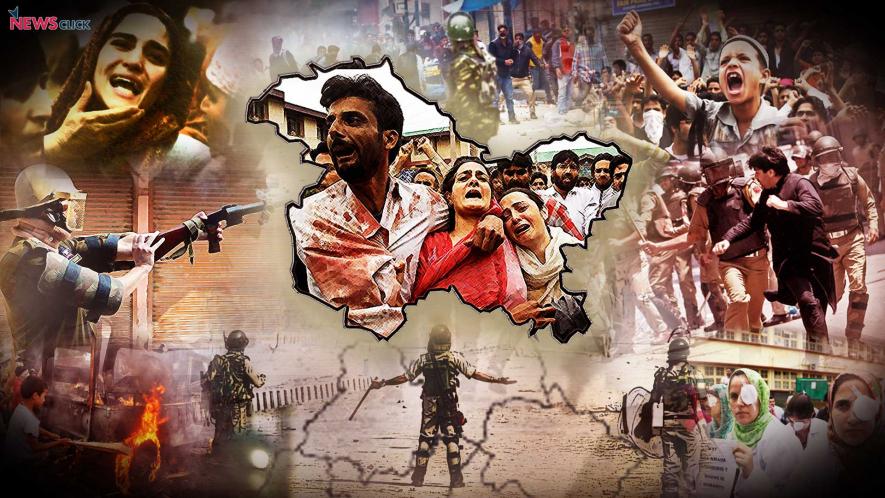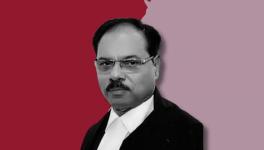Another Bloody Year Ends in Kashmir With No Signs of Improvement

Newsclick Image by Nitesh Kumar
2017 turned out to be a year full of violence and tumult for the state of Jammu and Kashmir. While there was no massive unrest, curfews and shutdowns like the previous year, 2017 witnessed a pile up of body count along with intermittent episodes of protests by Kashmiri people. There was a spike in militancy related incidents and well as the subsequent counter-insurgency operations. 212 militants were killed, highest since 2010, while security forces lost 78 of their own. 57 civilians were also killed in militancy related incidents, allegedly, most them in firings by the government forces.
The year 2016 witnessed a massive civil unrest in Kashmir following the killing of Hizb ul Mujahideen commander Burhan Wani. His killing set in motion a series of protests and demonstration which lasted for nearly six months. During the protests, nearly 100 civilians were killed and hundreds and thousands were injured, some of them fatally by so called non-lethal pellet guns. The pellet injuries also blinded dozens of youth and children in one or both of their eyes. A year after massive clashes and spell of violence, the number of militants in the valley had swelled by another hundred as youth mainly from South Kashmir had joined their ranks.
The state and counter-insurgency agencies responded by launching “operation all-out” to clear the militants from the valley. While the operation was being carried out, Kashmir witnessed a new wave of violence resulting in further deterioration of situation due to civilian protests, killings and massive crackdown.
Following are some of the incidents, issues and major events in Kashmir in the year 2017.
Civilian protests near encounter sites
For government forces, fighting off and eliminating two or three militants holed up in a house in South Kashmir was an easy task as counter-insurgency operations gained momentum towards the end of year 2016. The security forces, however, were faced with a new challenge near the encounter site as locals began interrupting their operations. The forces were being booed and pelted with stones by locals from the nearby villages around the encounter site. At many instances like in Pulwama and Tral, the militants were able to escape due to the distraction created by protesting locals. The protests resulted in several civilian killings in the alleged firing by state police and paramilitary troops. In the first three months of 2017, nearly a dozen civilians lost their lives. The incidents ended completely as the year proceeded until in December, when a similar incidents resulted in the killing of three civilians including a woman in South Kashmir’s Shopian.
Student protests
Another biggest challenge for the government and security agencies in Kashmir, which is as another fallout of the 2016 protests were the student protests which began with a protest in Government Degree College in Pulwama area of South Kashmir against the presence of army in the college premises. The forces allegedly responded with force and the students protests spread like wildfire across the state including in Chenab Valley of the Jammu province. Scores were reported injured in the incidents and the state government had to shut schools and colleges several times to stop the students from an assembly which would result in more demonstrations. The protests were spontaneous and paralysed the state for nearly a month especially the education and major city centers across the valley.
Spike in militancy
Another result 2016’s protests was a spike in militancy related incidents as more than a hundred local Kashmiri youth began joining militant outfits especially Hizb ul Mujahideen. The militants began by attacking families of J&K police personnel which resulted in a department circular directing policemen to avoid going to their respective homes especially in South Kashmir. The militants began vandalizing the homes of police personnel and threatening their families to counter the alleged police brutalities against their (militant) families. Incidents like these were widely reported for the first time since the armed insurgency began in Kashmir nearly three decades ago. Despite this, there was no major public outcry against the militants and many argued this as the “comeback of insurgents”.
The counter-insurgency operations went full swing with forces increasing their kill-count on an almost everyday basis. The forces killed top most wanted militant commanders in the ranks of both HIzb ul Mujahideen as well as Lashkar e Toiba - like Junaid Matoo, Bashir Lashkari, Yasin Yatoo and Abdul Qayoom Najar. Some of them had been active militants for over a decade. The number of mourners attending the funerals of all the militants increased but much to the respite of the state did not translate or manifest itself as a potent threat on the ground.
PDP’s ‘comeback’
As these events unfolded in Kashmir, the ruling People’s Democratic Party (PDP) suffered a push towards political hinterlands following 2016 protests. PDP faced massive public criticism first for their alliance with the right-wing BJP to form a government in Kashmir after the former had pledged their opposition against BJP during election campaigning. Secondly, PDP leaders especially Chief Minister Mehbooba Mufti made it apparent to the people that neither were they interested in diffusing the situation not had they any control over it. The mainstream political parties, it appeared, had lost the ground, until the controversy over the proposed abrogation of Article 35 A was raked up. The party along with all other mainstream parties including the main opposition National Conference (NC) joined hands to oppose the proposed move.
This was followed by central government led by BJP appointing Dineshwar Sharma, a former Intelligence Bureau (IB) man, as a negotiator to hold talks with all the stakeholders in the state. This also happened as “operation all out” was in full swing, but had failed to diffuse the deteriorating situation. Yet, the appointment of a negotiator is a change from the previous hard stance taken by the BJP government previously. Some argued that it is a total “u-turn” of BJP’s pervious stance.
But, whether this has managed to give respite to the ruling party PDP and the mainstream opposition parties is largely debatable. It should not be forgotten that this happened in the backdrop of raids led by National Investigating Agency (NIA) against the separatist leadership in the valley. As a result, the separatists stayed away from the dialogue process.
Right-wing rise in Jammu
The year 2017 was also significant for Jammu province which witnessed a rise in incidents of communal violence, like in most parts of the country. Hindutva right wing in Jammu was emboldened since BJP came into power at the center as well as the state. Violence was perpetrated against Rohingya Muslim refugees living in areas of Jammu.
During the year, Ladakh Province in the state also witnessed few incidents of incursion by the Chinese PLA amid the Doklam stand-off.
2017 is ending on a note of turmoil and the new year is also expected to throw multiple challenges for the state and the security agencies which have been grappling with a hostile population in the whole of the state. What happens in the few first months of the year will, of course, determine the course of the whole year.
Get the latest reports & analysis with people's perspective on Protests, movements & deep analytical videos, discussions of the current affairs in your Telegram app. Subscribe to NewsClick's Telegram channel & get Real-Time updates on stories, as they get published on our website.























